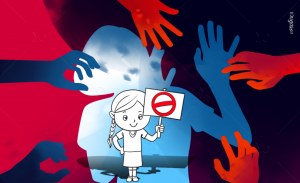Sanjita Ghimire, a woman in her young 20s, actively participated in demonstrations demanding justice for Nirmala Pant, a 13-year-old girl raped and murdered in June 2018, throughout the year in 2019. Occasionally, she also went to Maitighar Mandala of Kathmandu to demonstrate against the government’s inability to crack the mystery of the case.
There, she was given a placard that read, “Khapna sakdainau bhane kaatera rakha, tara balaatkar nagara” (Meaning: If you can’t resist your lust, cut your penis off. But, don’t rape”). As Ghimire stood and marched holding the placard, she was photographed by some anonymous guy. They posted the picture on social media platforms. And, in the blink of an eye, it just went viral.
Ghimire finds it difficult to remember what followed next. She was made subject to rounds of violence. “I very disturbed,” she says adding she was not sure where her life would have gone if her family and friends had not helped her overcome this.
Ghimire’s case is only the tip of the iceberg. There are many like Ghimire who has gone through online violence. But, unlike physical violence against women, technology-based violence is often overlooked because people do not know about it. Yet, its presence is pervasive.
Obscurity

Those working against sexual and gender-based violence say many victims like Ghimire even fail to realise that somebody is inflicting violence on them as the issue is rarely talked about. Many fail to understand the gravity of this problem and tend to normalise this, developing the culture of tolerance.
Rita Baramu, a feminist and programme manager at Body and Data, an organisation that integrates feminism, technology and internet rights, gender and sexuality says bullying, threatening, harassing or hurting anyone through the internet is called online violence, which many do not know.
Further, she explains that online violence is the extended form of gender violence that takes place in online space. Online violence takes place in various forms ranging from trolling to hate speech.
“Impersonation, doxing, sextortion and the publication of other’s sexual images/videos with an intention to harm them are some other forms in which online violence is taking place.”
In Ghimire’s case, the perpetrators were apparently involved in doxing. Its impacts were intolerable, yet no one but her saw them.
“My Facebook account was flooded with new messages and friend requests. Most of the messages were demeaning,” Ghimire recalls the one-and-a-half-year-old incident. “Some were slut-shaming me in the inbox as well as in comments openly. I even received threats from many men.”
This went for more than a month without anyone around her, except close family members and friends, noticing.
Root cause

But, not all incidents of online violence are as obscure. Just a few days ago, a video where two boys on a bike were publicly bullying Nikisha Shrestha, a transwoman who was walking on a road with Shrestha’s sister, went viral. In the wake of this incident, social media platforms were inundated with rage against such harassment. However, this incident was just a glance of bullying and trolling that Nikisha, a TikToker, has been facing for quite a long time.
The roots for this rampant problem lie in the socio-cultural structure of the patriarchal society, says Baramu. “The cause of this is no different than that of offline violence. It is just that nature and form are different.”
“We live in a society which has a certain type of culture that expects us to act in a particular way to fit in. If one can’t adjust herself in the pre-set criteria, society questions why this person is so.”
For instance, Baramu explains, there are norms that being a girl, one should not talk more or should not talk to strangers. And, when she goes online and her views about lifestyle reach many people, those with a patriarchal mindset can not withstand that. This incites violence in them.
The claim that patriarchy triggers online violence is supported by police data. SSP Deepak Thapa, the chief of the Metropolitan Crime Division of Nepal Police, states most victims of cybercrime have been women. Only in the first three months of the current fiscal years, 28 men have been arrested in connection to this offence, according to him.
Endless harms

Although men are responsible for such incidents in general, women are on the receiving end. They suffer from a lot of psychological disturbance, says Ghimire from her own experience.
“This shook me from within,” she says, adding, she, however, gradually realised that she had done nothing wrong to worry about. “And, all of those who were bashing me then were doing so in the absence of physicality anonymously. I, then, mustered all the efforts up and became strong to cope up with this challenge.”
Wounds and bruises are the most visible parts of offline violence. In the case of online violence, such traces are usually not seen. Still, this affects the victim physically, mentally, economically, and educationally, asserts Baramu.
How one can be affected physically while the form of violence is online? This may be hard to digest, but Baramu explains, “Suppose, while a couple is in a relationship, and they make a video or click photos of their intimate times. After breaking up, that guy pressurises her to have a forceful sexual relationship, if she does not agree, the guy threatens the lady to leak those private videos and photos. Can you imagine what happens next?”
Likewise, whenever someone trolls, passes negative or harassing comments, sends sexually harassing messages, it is no secret that they will directly harm the victim’s mental health and peace. They feel mentally tortured, threatened, irritated, and then seek isolation, says Baramu.
She describes the connection between mental health and its impacts on people’s work and academic productivity. When one’s mind is going through anxiety, this will directly be reflected in the work they do, their relationships, and their studies.
In addition, when virtual violence is extended to offline spaces like schools and colleges, there is a high chance that the victim may discontinue going to schools and college, says Baramu.
Control is possible

Considering the severe impact of online violence, the law has also made some provisions aiming at control of such activities. SSP Thapa informs, “When a complaint is registered, we immediately search for the alleged perpetrator by tracking their IP address. Then, depending on the severity of the case, we either make the two parties compromise to resolve the issue or file a case.”
However, there are some legal problems. Nepal does not have any specific law to deal with cybercrime. SSP Thapa says the police forward such cases for prosecution as per the Electronic Transactions Act, 2008, or Criminal Code, 2017.
“There are many loopholes in the system. That is why I feel only looking for a legal way to eliminate online violence is not enough,” the official says.
Activist Baramu agrees. Understanding root causes is the first step, according to her.
“Unless we don’t work to change the root cause, unless women and sexual minority group members get respected and treated equally as human beings, this problem can’t be eliminated.”
In the meantime, the survivors need to pay attention to self self-care (not blaming oneself for the happening), winning support from family, avoiding social media for some time, sharing with friends, and improving the security status of their media platforms to tackle this problem personally, suggests Baramu.
(Gaurav Pokharel contributed to this story.)
From the archive.


























